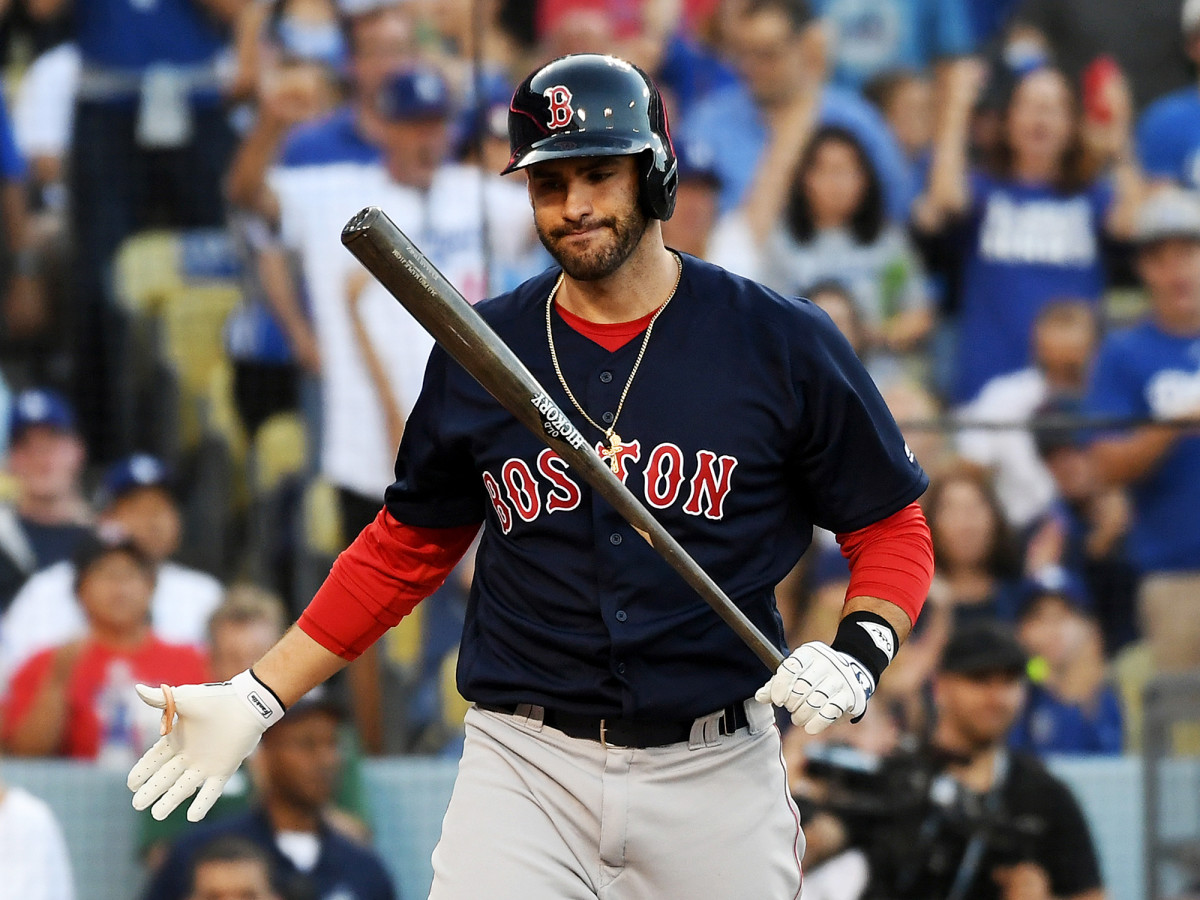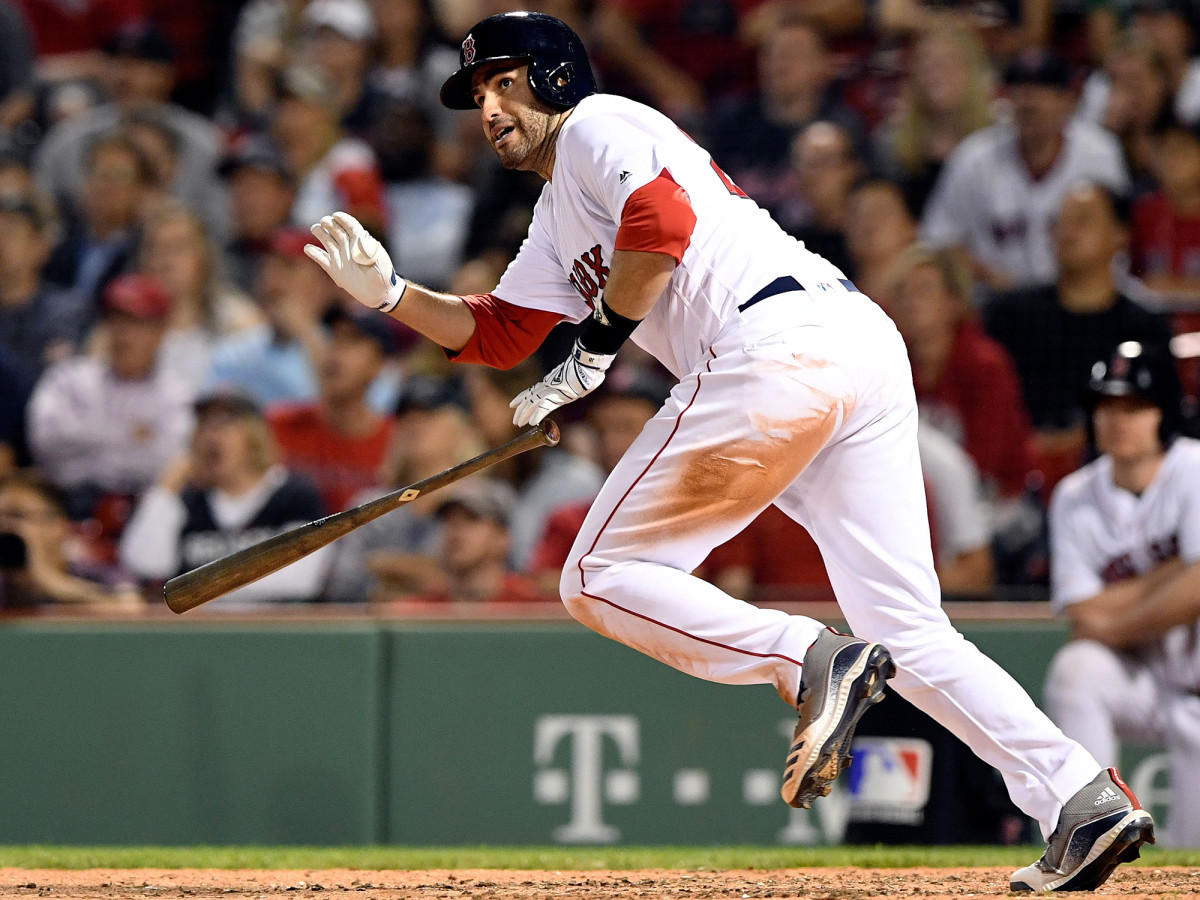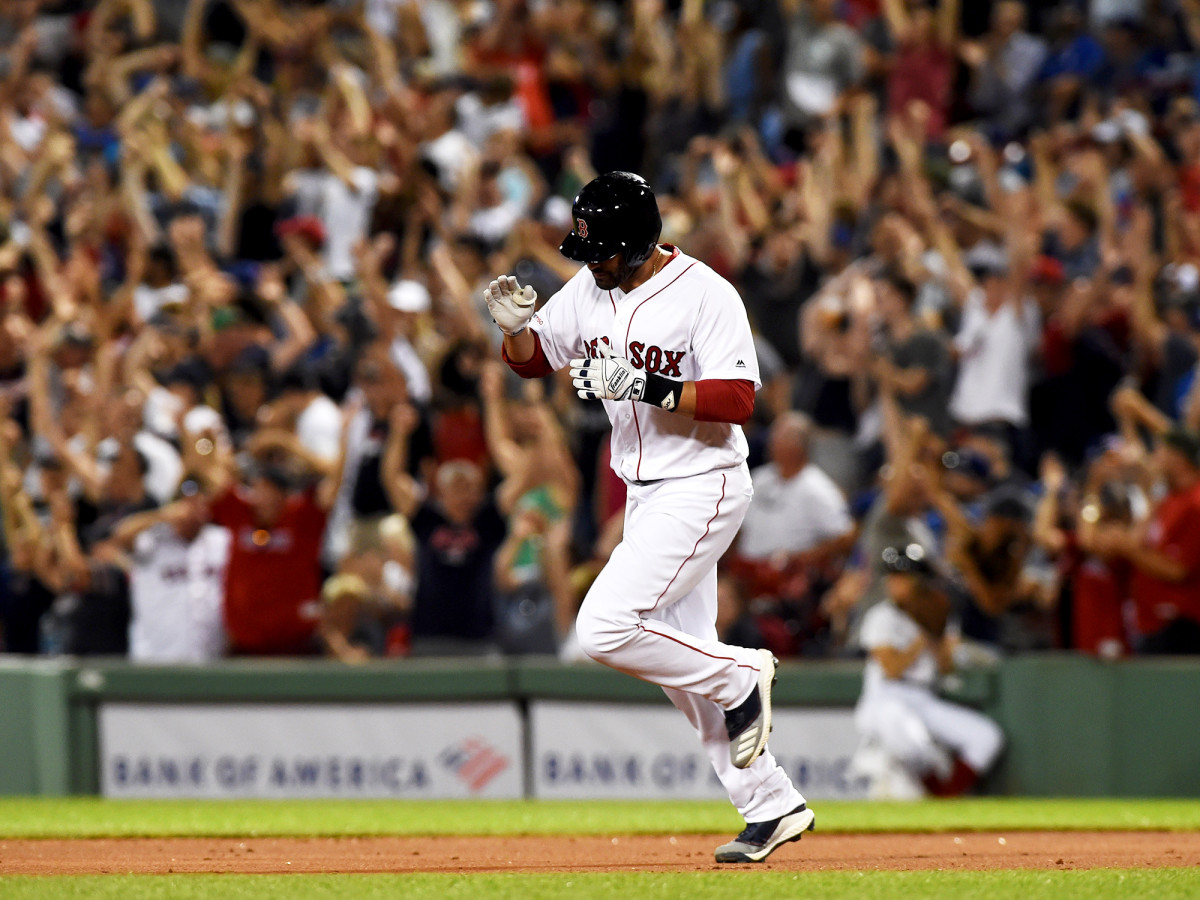'It's a Joke': J.D. Martinez Attacks Idea of Banning In-Game Video

FORT MYERS, Fla.— If you want to identify full-throated opposition to the potential ban on in-game clubhouse video, one hitter is your obvious go-to. It’s the guy who saved his career with video. It’s the guy who spends most of his time between at-bats studying his swing on video, making adjustments in the batting cage. It’s the guy who, over the past six years, has been the best slugger in baseball from innings seven through nine precisely because he uses video to tweak his swing and approach from the earlier innings.
When asked about the proposed ban, Red Sox designated hitter J.D. Martinez, like a ninth-inning smash over the Green Monster, did not disappoint.
“To take our game back 30 years, I think you’re not doing it justice,” Martinez said. “I think you’re just trying to do yourself a PR stunt … It’s a joke. It’s gotten so ridiculous.”

I asked Martinez if he had voiced his opposition to players’ association leaders, including MLBPA chief Tony Clark.
“Yeah,” he said. Martinez put his wrists together in the manner of someone being handcuffed. “Their hands are tied.”
Blame everybody’s favorite villain these days, the Houston Astros. Because Houston took measures far beyond other teams’ misuse of technology, MLB and the union owe it to the fans (and players) to announce tighter protocols that foreclose the possibility of another such scandal—to send a message that they are doing something.
Indeed, the game is better when it is decided on the field and not in back rooms with the aid of technology. There is preparation and there is competition, and the ban on in-game video keeps them separate (and keeps the sign-stealers at bay). Can you imagine Dustin Johnson running over to the range, between the fifth and sixth holes of a golf tournament, to hit some balls with a Trackman system?
The issue with the ban on in-game video is that, over the past half-decade, a generation of hitters has grown to depend on it. Nobody in that group will be more affected by such a ban than Martinez, one of the most technical hitters in the game.
“I think what people don’t get is there is a new generation that revolves around technology and analytics and seeing their swing,” Martinez said. “To me, studying my swing and making changes, that’s what makes me who I am. I got released doing it the other way.”
With Houston from 2011-13, Martinez slugged .387. That winter he launched a deep dive into the mechanical properties of his swing and discovered “everything I thought I knew about hitting was wrong.” Before his new swing took root, the Astros released him in spring training of ’14. Since then, with his new swing and analytical approach, Martinez has slugged .581 with the Tigers, Diamondbacks and Red Sox. Only Mike Trout has a better slugging percentage over those six years.
When you break down his slugging by inning, you can see how his in-game adjustments make him baseball’s best late-game slugger:
Martinez Slugging by Innings, 2014-19
Innings | SLG | MLB Rank |
|---|---|---|
1-3 | .549 | 12 |
4-6 | .627 | 2 |
7-9 | .577 | 1 |
I asked Martinez if he could give me an example of how he learned something from in-game video and applied it to a later at-bat. He laughed.
“My whole career!” he said. “There are times when I’ll go in there and say, ‘Damn, why do I feel jumpy?’ And then I go in and look at my video. ‘I’m not getting into my foot, I’m not getting into my knee, I’m not loading … All right, look at it right there.’ I go in there and next at-bat it’s like a I’m a completely different hitter.
“I’m sure there are some people are anti- [in-game video]. Those are natural hitters. I’m not a natural hitter. I had to teach myself how to hit. That makes me rely on it and there are similar players out there who feel the same way. Guys that rely on breaking their swing down and seeing what they’re doing wrong. Because it’s hard enough already.”
The ban on in-game video will affect hitters more than pitchers because hitters use it more often. Dodgers pitcher David Price, for instance, told me he found in-game video distracting.
“It’s something I try not to do,” he said. “It’s something I did years ago and I felt like it took away from my focus of the game. Once I walk off that field I want to be able to move forward. Mechanically, I’m more of a feel guy in that sense. That’s the last thing I want to be thinking about on the field—mechanics. I work on it in between starts and playing catch. When it’s game time, I want to go out there and compete. I don’t go into the video room to look at stuff.”
Over his 12 years in the big leagues, Price has seen a growing number of hitters rely on in-game video, especially in Boston.
“In Tampa Bay nobody other than Carlos Peña would go to the video room to look at their at-bats,” Price said. “I never really heard of it at the time. In Toronto some guys would do it. I’m not even sure in Detroit. It was up a lot of steps in the clubhouse. I didn’t see a whole lot of guys in there. Maybe Victor Martinez when he was the DH.
“In Boston it’s so close to the dugout, guys would come in, get their high fives, their pats on the back and go right in. They want to go back in and see what the pitch looked like or why they missed a certain pitch, whatever it is. It was big.”
Martinez almost never takes a swing that is not recorded. He introduced to the Red Sox the use of tablets to record batting practice swings. He spends his time between at-bats in the cage, where he follows the game on a television monitor and in the video room. Under new proposals, the monitor in the cage and the video room would go dark this year.
“I’m a DH,” he said. “This is going to affect DHs across the board. What the hell are we going to do for three innings when we’re sitting there waiting to hit again? That’s what we do: watch the game, study our swings, study my teammates’ swings … ‘Devers, I think you’re coming off, you’ve got to do this …’
“I guarantee I’ll be late one time to the box this year [without a cage TV]. Everybody will go, ‘Where the [bleep] is J.D.?’ And I’m going to say, ‘Sorry, guys.’”

Martinez also warned that the proposals will make players less accessible to media after games.
“What happens after the game when you want to come in and say, ‘Hey, J.D., talk about that home run,’” Martinez said. “Do you think I’m going to go talk to you? No. I’m going to be in the [bleeping] video room watching my [bleeping] swing for the next hour trying to figure out my swing and ‘Hey, Tom, you want to wait for me?’
“All the media guys. I’ll tell ‘em to go kick rocks right away. ‘Sorry, boys. I’ve got to do this [bleep]. This is more important than talking to you guys.’
“Then you’re going to have not just me—nine of us with the hitting coach. The hitting coach is going to have to stay two hours after the game to break down video with the hitters. This is stuff that everybody does during the game, like how they go over their swing.
“I don’t think that [the ban] would be the fair thing to do. You’re setting us all back as an offense, the entire MLB, back to whenever they didn’t have film. The 1980s probably? They probably had in-game bat feeds in the mid-‘90s. So, you’re setting us back 30 years. What are we doing?”
What MLB is doing is trying to make sure another Astros scandal doesn’t happen. Houston used live game feeds to steal signs in real time and to decode the sequence of signs teams used with a runner at second base. Martinez understands the reactionary nature of the ban but disagrees with the removal of in-game video.
“To me it’s overkill,” he said. “The message has been sent. People are losing jobs. It’s like the steroid thing. You do that and there’s a punishment. Steroids are still out there. Do they use them? Some do, but they’re prepared to take the risk. So here it is: you want to risk it, there you go.
“That’s not what [the ban] is about. To me it’s not an answer. It’s hiding from the situation and trying to justify it PR-wise.”
Martinez said the answer can be found in tighter protocols on the video loggers who record every pitch. He recommends a requirement that loggers cannot press record until after the catcher gives the signs.
“To go about it in this way, it’s going to be like that scab, that injury that you had, and you’re just going to keep picking over and over,” Martinez said. “Just think, all it’s going to take is one hitter to go 0 for 12 or one pitcher to go out there and get lit up who relies on that stuff that blows up on the whole media thing. It’s going to happen. And then you’re right back in the same situation, looking like crap and the whole thing is back up.
“I go back to the steroids thing. If you make the punishment a certain way, there’s a line. You want to play with it, go play with it. That’s the risk. Everybody sees the line. You can go down the street, to GNC or something, and get some stuff you can get popped for. You can do it. It’s the same situation here. It’s there. You can go do it. You take your risk.”

Moreover, Martinez noticed that stealing signs has become much more difficult in the past year or so because teams routinely switch among multiple sets of signs, even with no runner at second base.
“It’s already gotten to an age where pitchers are so paranoid, and you’ve seen it, where in New York they started pulling index cards out and then we started doing it,” he said. “You can’t pick that stuff up.
“If you’re the idiot that [gives] the simplest [signs], it’s on you. You’re going to get caught. But there are so many different ways. I think pitchers already are so paranoid as it is that it’s overkill, is what I’m saying.”
The Red Sox are under investigation for their own sign stealing in the ’18 season. MLB launched the investigation in mid-January with an expectation it would conclude before spring training. Then commissioner Rob Manfred suggested Feb. 16 it would wrap within a week. It remains active. Now next week appears to be the target.
The Red Sox are hoping that an investigation that has gone on for two months and extends at least three weeks past its expected due date will somehow turn up nothing.
Multiple sources indicated investigators are looking at whether Red Sox personnel violated rules by using the replay monitor to decode sign sequences with a runner at second base. In ’18 Boston hit .292 with a runner at second base, 45 points better than league average, nine points better than the next best team (Minnesota), and the highest in baseball in five years. (The ’19 Yankees surpassed that mark at .303.) The Red Sox already were penalized in ’17 by using the replay monitor to decode signs and transmitting them to the dugout via a smart watch.
Manfred has promised new protocols will be in place before Opening Day that give players less access to live video in games. Replay monitors could be moved to “safe” rooms farther removed from dugouts and clubhouses. The ’17 Red Sox put baseball on notice regarding the misuse of technology. The ’17-’18 Astros created an integrity crisis. The ’18 Red Sox are under investigation for similar, if lesser, misbehavior. Manfred and Clark were duty-bound to react to the scourge. Hitters such as Martinez are worried baseball is going too far—so far that the new protocols might take some offense out of the game.
“To me it’s not the fix,” he said. “I think it’s the Band-Aid.
“I think it’s just going to change players. All these kids coming up, that’s what they had. It’s a generation that grew up on it and now all of a sudden you’re taking it away and that’s a helluva crutch a lot of players lean on. Baseball’s just frustrating enough as it is.”
